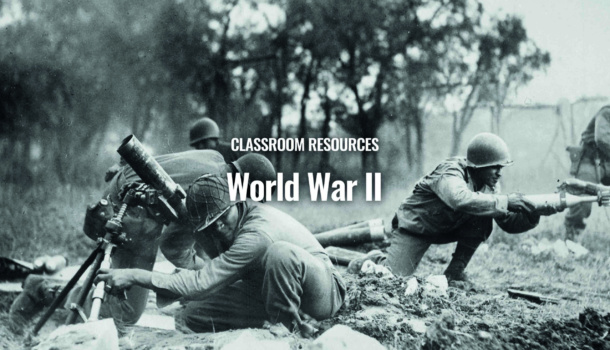World War II
An absorbing investigation into the most devastating conflict in human history and its significance for students today.
It is now over 80 years since World War II began. As the number of those who served in the war diminishes, more and more first-hand accounts of the war are lost. Pupils in school today can no longer ask their parents or grandparents what they did during the war. Pupils would now have to ask their great grandparents and great, great grandparents. Any survivors of the war-years would be octogenarians, nonagenarians and centenarians.

The wealth of knowledge of people who lived during the Second World War is disappearing, but the young of today can still take a fascinating journey into their family’s past.
There is no longer a direct connection to the history of the events of World War II for pupils. For many, it is textbooks doled out in a lesson. Using research into their family history will enable pupils to relate to real people who were called upon to do a difficult and sometimes terrible job.
On their journey, pupils will discover the enormous array of resources within their own homes, starting with sepia-tinted photos, diaries, letters and sometimes a family bible. This is the starting point that will help to organise and direct young researchers towards the resources available on the Internet. Helping pupils to gain an insight into those who lived, served, died and survived goes some way to ensuring that we all never forget the price we pay for the freedoms we enjoy.
World War II Project Overview (Open Access)
.png)
‘Sadako Sasaki’ text
The real-life story of one inspirational young girl and the effects the bombing of Hiroshima had on her short life.
Activity 1: Card sort and research exercise
Students identify events leading to World War II and their links to World War I.
Includes instructions and:
- Activity sheet 1a – Student introduction
- Activity sheet 1b – Date and event cards (to cut out and distribute)
- Activity sheet 1c – Student grid
- Activity sheet 1d – Answer sheet
Activity 2: Causation sort
In this activity, pupils use the historical event cards from Activity 1 to discuss whether the event is a long term cause, a short term cause or if it’s the trigger event. This cumulative learning approach enables students to connect their new learning to their current understanding. Students then write an explanation of the events leading to World War II. Includes instructions and:
- Activity sheet 2a – Student introduction
- Activity sheet 2b – Student worksheet
- Activity sheet 2c – Explanation writing help sheet
Activity 3: Report writing
Students write a report detailing the events that led to war. Includes instructions and:
- Activity sheet 3 – Report writing help sheet
Activity 4: The home front
This activity requires students to use investigative skills to discover the importance of the home front and its impact on the war effort. Includes instructions and:
- Activity sheet 4a – Student introduction
- Activity sheet 4b – Sources
- Activity sheet 4c – Student worksheet
Activity 5: Multimedia presentation
Students analyse and evaluation information about different aspects of the home front and present it in a multimedia manner. Includes instructions and:
- Activity sheet 5 – Student introduction
Activity 6: Researching family history
For this activity, students use research skills to discover ancestors/relatives who may have taken part in or grown up during the Second World War. Includes instructions and:
- Activity Sheet 6a – Student introduction and guide
- Activity Sheet 6b – Information collection sheet
- Activity Sheet 6c – Pedigree chart template
- Activity Sheet 6d – Pedigree chart example
- Activity Sheet 6e – Circular pedigree chart
- Activity Sheet 6f – Circular pedigree chart example
- Activity Sheet 6g – Family tree example
- Activity Sheet 6h – Brainstorm template
- Activity Sheet 6i – ‘My wartime relative’ information collection sheet
- Activity Sheet 6j – Life on the front line interview prompts
- Activity Sheet 6k – Life on the home front interview prompts
- Useful websites sheet
Activity 7: Can the bombings of Hiroshima and Nagasaki be justified?
Students undertake a historical, philosophical and moral investigation into the bombings of Hiroshima and Nagasaki to come to an informed opinion on whether the US should have dropped the atomic bombs. Includes instructions and:
- Activity sheet 7a – Student introduction
- Activity sheet 7b – Hiroshima before and after the bombing
- Activity sheet 7c – Detonations of the atomic bombs
- Activity sheet 7d – The effects of the atomic bombs (Warning: Contains graphic images of survivors of the bombings)
- Activity sheet 7e – Enola Gay and Bockscar
- Activity sheet 7f – Statistics
- Activity sheet 7g – Eyewitness accounts
Activity 8: Reading the text
Students take on a reading role and read the text ‘Sadako Sasaki’ from that perspective, contributing to a group record sheet. This activity encourages active thinking and reading and encourages students to work collaboratively, but independently. Includes instructions and:
- Activity sheet 8a – KWL grid
- Activity sheet 8b – KWHL grid
- Activity sheet 8c – Group roles cards
- Activity sheet 8d – Lotus diagram template
- Activity sheet 8e – Mandala collection sheet
Activity 9: P4C enquiry
Conduct an enquiry based upon questions raised by the pupils, related to and about the text ‘Sadako Sasaki’. Students identify a key issue which had arisen for them out of their study of the text to explore in depth. It is highly likely that the pupils’ lines of enquiry will focus on ethical issues and issues of social justice. Includes detailed activity instructions and guidelines.

Conflict and genocide
A compilation of thought-provoking websites and online resources to support teaching about war, conflict and genocide across the curriculum.
